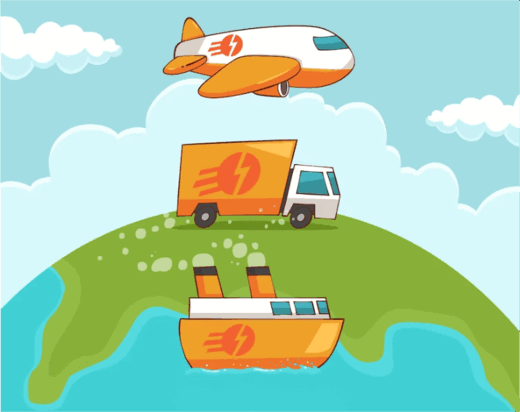 Trade Logistics
Trade Logistics
 2023-06-27
2023-06-27
Importing goods from China to the United States requires careful consideration of the most suitable transportation method. Two popular options for shipping are sea freight and air freight. In this article, we will compare the differences between these two methods, discuss the types of products suitable for each, explain the pricing calculations for sea and air freight, and highlight the import restrictions and requirements imposed by the United States for these transportation modes.

The Distinctions Between Sea Freight and Air Freight:
·Sea Freight:
Sea freight involves shipping goods via cargo vessels across the ocean. It is known for its cost-effectiveness and suitability for transporting large volumes of goods. However, it typically has longer transit times compared to air freight. Sea freight is ideal for bulky or heavy products that are not time-sensitive, such as furniture, machinery, and large quantities of consumer goods.
·Air Freight:
Air freight, on the other hand, entails transporting goods by airplanes. It offers faster transit times and is ideal for time-sensitive shipments. While air freight is generally more expensive than sea freight, it provides advantages in terms of speed, security, and reliability. Air freight is suitable for perishable goods, high-value products, electronics, and products with shorter shelf lives.
Pricing Calculations for Sea Freight and Air Freight:
One of the key considerations when importing from China is the transportation costs and efficiency. Sea freight is generally more cost-effective compared to air freight, especially for large volumes of goods. However, it typically has longer transit times. Air freight, on the other hand, offers faster delivery but comes at a higher cost. It is important to assess the cost implications and evaluate the trade-off between speed and cost based on your specific product and business requirements.
·Sea Freight Pricing:
Sea freight rates are determined by various factors, including the shipment's weight, volume, container size, and destination. Shipping companies typically offer different types of containers, such as full container load (FCL) and less than container load (LCL), which impact the pricing. Additionally, additional costs may arise, such as customs duties, port charges, and insurance fees. It is advisable to request quotes from multiple freight forwarders to compare prices and choose the most cost-effective option.
·Air Freight Pricing:
Air freight rates are primarily influenced by the weight and volume of the goods being shipped. Airlines use a chargeable weight calculation, considering either the actual weight or the dimensional weight—whichever is higher. Dimensional weight is calculated based on the package's size, and it helps airlines account for the space occupied by lightweight, bulky shipments. Additional costs, such as security charges and fuel surcharges, may also be included in the overall air freight pricing.
Product Suitability Between Sea Freight and Air Freight:
Different transportation methods have their own strengths and suitability for specific types of products. Sea freight is ideal for bulky, heavy, and non-time-sensitive products. Goods such as furniture, machinery, and large quantities of consumer goods are well-suited for shipping via sea freight. On the other hand, air freight is more suitable for time-sensitive shipments, perishable goods, high-value products, electronics, and items with shorter shelf lives. Understanding the nature of your products and their specific transportation needs will help you determine the most appropriate method.
Transit Times for Sea Freight and Air Freight:
Transit time is an important consideration for importers. Sea freight generally has longer transit times due to the nature of transportation via cargo vessels and multiple port stops. On average, it takes several weeks for goods to reach the United States from China via sea freight. Air freight, on the other hand, offers significantly shorter transit times, typically ranging from a few days to a week. Consider your inventory management, sales planning, and customer demands when deciding between sea freight and air freight.
Reliability and Security Between Sea Freight and Air Freight:
The reliability and security of the transportation method are critical factors to consider. Sea freight, despite longer transit times, is generally considered reliable and secure for shipping goods. Cargo vessels have robust safety measures in place to protect shipments. Air freight, with its shorter transit times, offers a higher level of security and minimizes the risk of theft or damage during transportation. It is advisable to work with reputable shipping companies or freight forwarders that have a proven track record in handling imports from China to the United States.
Import Restrictions and Requirements in the United States:
Both sea freight and air freight shipments from China to the United States are subject to import restrictions and requirements imposed by U.S. customs and regulatory authorities. These restrictions aim to ensure product safety, protect intellectual property rights, and prevent the entry of prohibited goods. The specific requirements vary depending on the type of product being imported, and it is essential to comply with them to avoid penalties and delays. Some common import requirements include:
Product certifications and compliance with relevant standards
·Accurate labeling and packaging
·Intellectual property rights protection
·Documentation, including commercial invoices, packing lists, and certificates of origin
·Adherence to customs valuation and classification rules
·Compliance with specific regulations for certain product categories, such as food, pharmaceuticals, and electronics
Conclusion:
When importing goods from China to the United States, choosing the best transportation method is crucial for a successful and cost-effective operation. Sea freight is suitable for bulky and non-time-sensitive products, offering cost advantages despite longer transit times. On the other hand, air freight provides faster delivery for time-sensitive and high-value goods, albeit at a higher cost. Understanding the differences between sea and air freight, including pricing calculations and import restrictions, enables importers to make informed decisions and optimize their import processes.
Category
Leave Message for Demo Request or Questions


 T-info
T-info T-discovery
T-discovery

 My
Tendata
My
Tendata Market Analysis
Market Analysis Customer
Development
Customer
Development Competitor
Monitoring
Competitor
Monitoring Customer Relationship
Customer Relationship





































































































































